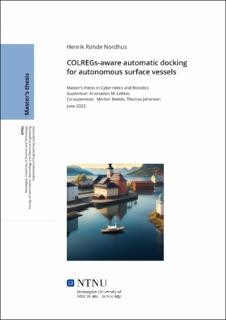| dc.contributor.advisor | Lekkas, Anastasios M. | |
| dc.contributor.advisor | Breivik, Morten | |
| dc.contributor.advisor | Johansen, Thomas | |
| dc.contributor.advisor | | |
| dc.contributor.advisor | | |
| dc.contributor.author | Nordhus, Henrik Rohde | |
| dc.date.accessioned | 2023-10-04T17:21:28Z | |
| dc.date.available | 2023-10-04T17:21:28Z | |
| dc.date.issued | 2023 | |
| dc.identifier | no.ntnu:inspera:140443607:34564098 | |
| dc.identifier.uri | https://hdl.handle.net/11250/3094271 | |
| dc.description.abstract | I en æra hvor autonome systemer i økende grad former industrier og hverdagsliv, har området for maritim navigasjon opplevd en betydelig transformasjon. Denne masteroppgaven viser fremskrittene som er gjort i dokkingsprosedyrer, spesielt for autonome overflatefartøy (ASV), innenfor dynamiske og komplekse maritime områder. Den presenterer det komplekse problemet med å dokke ASV-er samtidig som man overholder Konvensjonen om internasjonale regler for å forhindre kollisjoner til sjøs (COLREGs).
Nylig arbeid av Ødven (2022) har vist lovende resultater i forbindesle med dokking for autonome overflatefartøy (ASV) ved å kombinere geometri og ikke-lineær kontrollteori. Triangulering brukes til å generere veipunkter med tryg avstand fra havner og hindringer. En søkealgoritme navigerer gjennom disse veipunktene for å identifisere den korteste kollisjonsfrie banen fra den opprinnelige plasseringen til fortøyningspunktet. Deretter løses et ikke-lineært optimalt kontrollproblem (NOCP) numerisk for å gi den optimale kontrollsekvensen som passer til denne banen. Begrensninger som representerer havnen og eventuelle hindringer er sømløst integrert i denne tilnærmingen for å sikre sikker navigasjon.
I en innovativ utvidelse av disse metodene, benytter denne avhandlingen et kollisjonsforebyggende (COLAV) system som tar hensyn til COLREGs for å identifisere hvilke regler som er relevante for et spesifikt scenario, og dermed legge til rette for realistiske ASV-manøvrer. Andre bidrag inkluderer en ny baneglattende algoritme som sikrer en kollisjonsfri bane og tar hensyn til COLREGs, samt en adaptiv tilnærming til å justere antall tidssteg i MPC for å balansere beregningstid og nøyaktighet.
Funnene i denne avhandlingen bidrar til det voksende feltet av ASV-forskning, og tilbyr innovative strategier og algoritmer som forbedrer dokkingsikkerhet, effektivitet og overholdelse av internasjonale forskrifter. Videre viser resultatene at kombinasjonen av triangulering og søkealgoritmer for å oppnå en kollisjonsfri bane, kombinert med optimal kontrollteori, presenterer en gjennomførbar og lovende løsning for automatisering av dokkingproblemet. Ved å bruke en optimaliseringsbasert tilnærming, kan fartøyet opprettholde sin dynamikk mens det tar hensyn til begrensningene av aktuatorer og andre fysiske begrensninger. | |
| dc.description.abstract | In an era where autonomous systems are increasingly shaping industries and everyday life, the field of maritime navigation has witnessed a significant transformation. This Master’s thesis showcases the advancements made in docking procedures, specifically for Autonomous Surface Vessels (ASVs), within the dynamic and intricate maritime environment. It presents an exploration into the complex problem of docking ASVs while adhering to the Convention on the International Regulations for Preventing Collisions at Sea (COLREGs).
Recent work by Ødven (2022) has shown promise in solving the docking problem for ASVs by combining computational geometry and nonlinear control theory. Triangulation is utilized to generate waypoints at safe distances from harbors and obstacles. A search algorithm navigates through these waypoints to identify the shortest collision-free path from the initial location to the docking point. Subsequently, a nonlinear optimal control problem (NOCP) is numerically solved to yield the optimal trajectory and control sequence corresponding to this path. Spatial constraints representing the harbor and any obstacles are seamlessly integrated into this approach to ensure safe navigation.
In an innovative extension of these methods, this thesis utilizes a collision avoidance (COLAV) system considering the COLREGs to identify rules relevant to a specific scenario, thereby facilitating realistic ASV maneuvering. Other contributions include a novel path-smoothing algorithm that ensures a collision-free path and takes COLREGs into account and an adaptive approach to adjusting the number of time steps in the MPC to balance computational time and accuracy.
The findings in this thesis contribute to the growing field of ASV research, offering innovative strategies and algorithms that enhance docking safety, efficiency, and compliance with international regulations. Moreover, the results show that combining triangulation and search algorithms to obtain a collision-free path, combined with optimal control theory, presents a feasible and promising solution for automating the docking problem. By employing an optimization-based approach, the vessel can uphold its dynamics while accounting for the constraints of actuators and spatial limitations. | |
| dc.language | eng | |
| dc.publisher | NTNU | |
| dc.title | COLREGs-aware automatic docking for autonomous surface vessels | |
| dc.type | Master thesis | |
